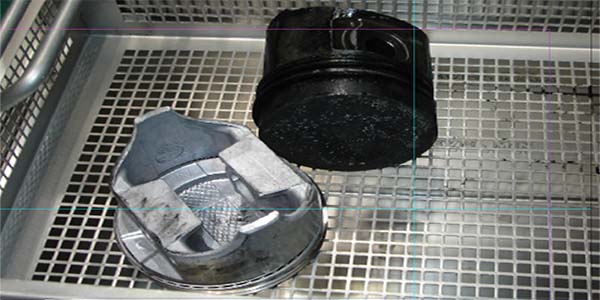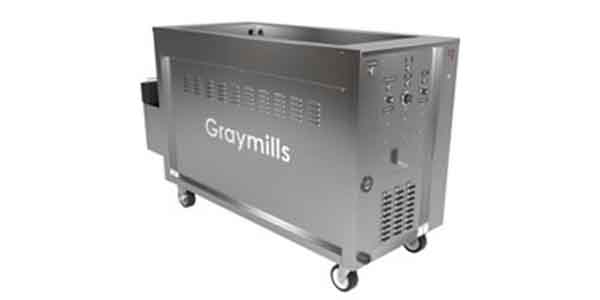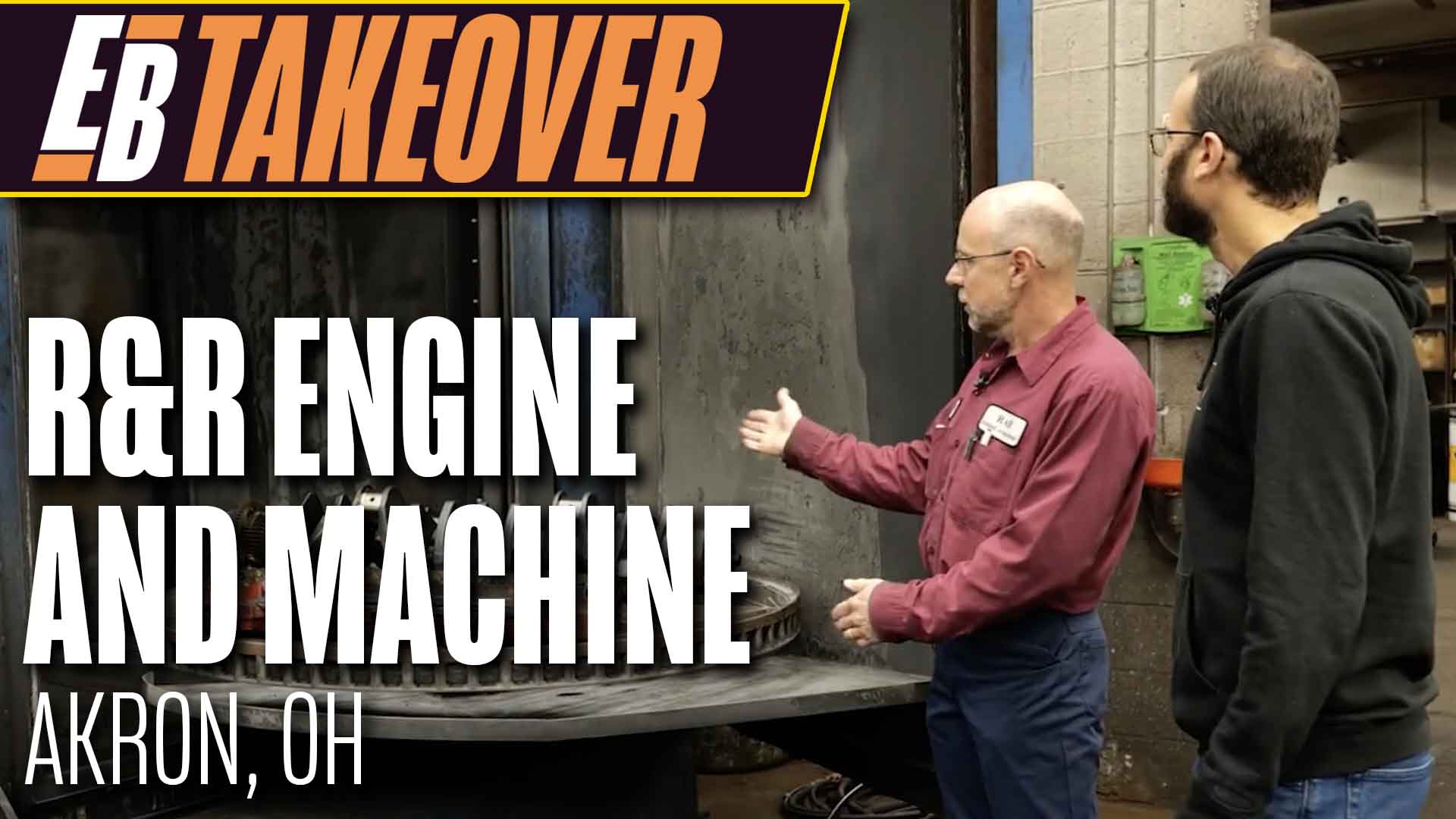Cleaning is a process that no engine builder can avoid, whether you are rebuilding high mileage engines caked with gunk and full of gunk, or you are working with all brand new components and castings. Oil, grease, dirt, carbon, rust and lime deposits are all contaminants that must be removed so parts can be inspected, reconditioned, machined and assembled. Even brand new parts and castings require cleaning after they have been machined, ground or honed.
Getting down to bare metal requires a cleaning process that is quick, efficient, affordable and safe. It’s hard to be productive and profitable if you are spending too much time cleaning parts instead of machining parts. The focus of this article is on chemical cleaning, so we will leave thermal cleaning, abrasive cleaning and soda blasting for future articles. These other cleaning processes may be used in conjunction with chemical cleaning to achieve the level of cleanliness you require.
Chemical cleaning boils down to two basic types of products: solvents and aqueous (water-based) cleaners and detergents. Both can be equally effective for cleaning cast iron and aluminum, and both are available in special formulations for specific applications. A supplier may offer a single product for cleaning both cast iron and aluminum, or a special product for each.
The basic difference between solvents and aqueous cleaners is that solvents dissolve contaminants in the cleaning solution while water-based detergents emulsify and encapsulate contaminants so they can be washed away. Water and oil won’t mix so detergents use a special ingredient called a “surfacant” to lift dirt and oil away from the surface of the metal. The surfacant molecules act like the opposite poles on a bar magnet. One end attracts oils and dirt while the other end attracts water. This allows the detergent to pull the oil and dirt away from the surface and mix it with water so the contaminants can be washed away. Other ingredients called “chelating agents” and “builders” are added to the detergent to prevent hard water and metal ions from interfering with the cleaning process. Additional “wetting agents” may also be added if a water-based cleaning product will be used in a tank with ultrasonics.
SOLVENTS
Automotive cleaning solvents are liquid products that are typically made from petroleum distillates, naphta, stoddard solvent, light mineral oils, and organic or synthetic compounds. The exact formulation of any given solvent will vary on its application and intended use.
If you need specific details about a cleaning product, refer to its Material Safety Data (MSD) sheet. The sheet (which is required by law) spells out the product’s physical and chemical properties, including its flammability rating and any health hazards associated with its use. There may be additional information on safe handling and disposal requirements.
Solvents have long been popular in the automotive industry because they are very effective at cleaning small engine parts. A little hand scrubbing in a basin parts washer quickly dissolves and rinses away most oil, dirt, grease and carbon deposits. Really thick hard carbon deposits that are baked on pistons, valves, combustion chambers or exhaust ports may require more scrubbing or abrasive cleaning to dislodge. But for most automotive cleaning applications, solvents work great.
Unfortunately, solvents have been in the crosshairs of government regulations for the past couple of decades. Traditional solvents have some major drawbacks. The are flammable (no smoking please!), they give off Volatile Organic Compounds (VOCs) that are bad for air quality, and they can be hazardous to use (both short term and long term health exposure risks). Depending on the chemical makeup of the solvent, it may be classified as a hazardous material that requires special handling, recycling and disposal procedures. This adds to the cost of using the solvent as well as “cradle to grave” liability risks if there is a spill or disposal issue. Major solvent suppliers usually offer a pickup and recycling service.
The latest generation of solvents have been reformulated to have higher flash points (over 140 to 170 degrees F) so they are less flammable and less dangerous to use. They have also been reformulated to reduce or eliminate VOCs so they can be VOC compliant in areas that have strict VOC regulations. Some of these solvents are citrus-based (limonene) or contain naptha or terpenes.
Solvents still account for 60 to 70 percent of the automotive chemical cleaning market, according to one supplier, but aqueous-based cleaners are gaining ground with non-flammable, low or no VOC formulations that have little or no health risks. Some of these aqueous-based cleaners also use a process called “bioremediation” to break down oils and dirt with special bacteria to extend the life of the cleaning solution and minimize disposal issues and cost.
If you are still using solvents to clean engine parts, choose a product with low or no VOCs to minimize exposure to potentially hazardous chemicals. Wear gloves and eye protection when using a parts washer basin and avoid skin contact. Compare the MSD sheets for competitive products and choose the “safest” one to protect yourself and your employees from potential health risks that may result from prolonged exposure to the chemicals in the solvent. Or, consider switching to an aqueous cleaner.
AQUEOUS CLEANERS
Water-based cleaners have a number of important advantages such as nonflammability, low or no VOCs and few if any health risks. Most aqueous cleaners are also biodegradable. However, there are questions over how effective some of these products are at removing oil, dirt, grease, rust and scale from automotive engine parts and castings.
Some of the older first generation water-based products were slow acting and did not clean very well without lots of scrubbing, lots of heat and/or high pressure spray washing. But over time, water-based detergents and cleaners have evolved into products that are as effective as solvents without the safety, health and environmental concerns.
Back in the day when most engines were cast iron, the block, heads and other parts were often cleaned by submerging the parts in a hot tank filled with a caustic solution. Caustics such as sodium hydroxide (lye) work great on cast iron but are way too aggressive on aluminum. So as aluminum heads, blocks, intake manifolds, timing covers, valve covers, etc, became more and more common, the industry moved away from caustic hot tanks to other processes such as high pressure spray washers with detergent solutions or soda blasting to clean aluminum engine parts. Environmental regulations also put the nix on caustics in many areas by labeling them hazardous wastes. This further accelerated the effort to switch to more environmentally-friendly alternatives. Hot tanks were also big energy wasters and expensive to operate because the solution had to be kept at high temperature (180 degrees F or higher).
Although many aqueous cleaners can be used at room temperature, heating the cleaning solution can help improve its cleaning effectiveness. Some products work amazingly well if heated to 150 to 160 degrees, while others may only need to be warm (105 degrees F or so) to do their job. Aqueous cleaners that use bioremediation typically prefer a little heat to keep the microbes active in the tank. This helps break down the contaminants more quickly so the solution will remain clean. Aqueous cleaners that do not use bioremediation will gradually become dirtier and dirtier with use, even with filtration, and will eventually have to be replaced.
One of the drawbacks of aqueous cleaners is that they are water-based, which may cause iron parts to flash rust after cleaning unless the cleaner contains a rust preventative or the parts are sprayed after cleaning with a water-displacing aerosol.
Some water-based cleaners cleaners are “pH neutral” which means they are no more corrosive than water and will not etch aluminum or cast iron. More aggressive cleaners for removing heavy dirt or carbon deposits may be formulated with a much higher pH rating (like 10.7, which makes them more alkaline).
Water-based cleaners and degreasers are usually sold in concentrated form that is added to water. The mix ratio may range from 5 percent up to 20 percent or more depending on the product and its intended use. Water is a key component because water acts much like a solvent to suspend and flush away the contaminants once the detergent or degreaser has done its job and loosened the oil and dirt from the surface of the metal. The detergent alone can’t do the job. It must be used in combination with lots of water to get the parts clean.
When used with ultrasonics, water-based cleaners can be very quick and effective at cleaning dirty engine parts. The high frequency vibrations created by an ultrasonic transducer creates a microscopic scrubbing action at the molecular level that literally blasts dirt, oil and grease loose from the surface. Dip a dirty part in an ultrasonic tank and the gunk starts to vanish as fast as campaign promises following an election.
CHOOSING A CLEANER
There’s no pat answer for determining the “best” cleaning solution for your shop. It depends on how dirty the parts are that you typically have to clean, whether you are working mostly with aluminum, cast iron or both, and local environmental regulations.
Cost is another factor to consider. In general, solvents are less expensive than aqueous cleaning solutions when you are buying them by the gallon, But some aqueous cleaners are highly concentrated, so are actually much less expensive when you add water.
For example, a 20 gallon parts washer would require 20 gallons of solvent versus one or two gallons of concentrated aqueous cleaner plus 18 to 19 gallons of water. When you look at it this way, the cost of the aqueous cleaner is much less. However, as we mentioned earlier, some aqueous cleaners work best with heat so you also have to factor in the added cost to heat the cleaning solution. The parts washer basin may also have to be stainless steel (more expensive) to resist rust.
Another factor to consider when choosing a cleaning solution is the cost to recycle or dispose of the dirty solution. With solvents, you have the added cost of a service to pick up and recycle your dirty solvent on a regular or “as needed” basis. With aqueous cleaners that use bioremediation, the microbes keep the solution clean so other than adding make-up water and cleaner periodically, disposal costs are minimal or nonexistent. The only required maintenance may be a periodic filter change.














